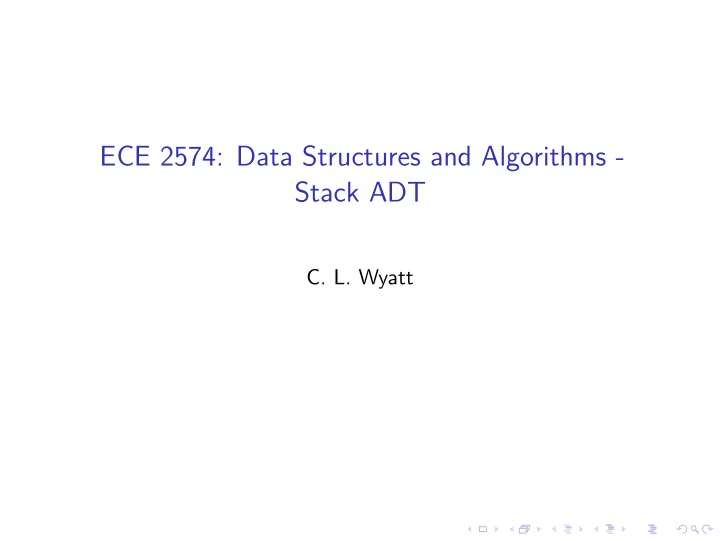

ECE 2574: Data Structures and Algorithms - Stack ADT C. L. Wyatt
Today we will defjne and use one of the most fundamental data structures in computing, a stack. ◮ Warmup ◮ Introduction to stacks ◮ Example: permutations ◮ Example: image processing
A stack is a list in which all insertions and deletions are done at one end, denoted the top. The basic stack ADT has 7 operations. In the stack, all access is limited to the top . ◮ create a stack ◮ destroy a stack ◮ empty query ◮ insert (push) ◮ remove (pop) ◮ retrieve (peek or top)
A stack is also called a Last-In-First-Out (LIFO) Queue. Example of using a stack: Entering text
Basic stack operations are similar to the Bag ADT. // Create an empty stack +createStack() // Destroy a stack +destroyStack //Determine if a stack is empty //Precondition: None //Postcondition: returns true is the stack is empty, // else false +isEmpty(): boolean
Inserting onto a stack is called a push. // adds new item to the top of the stack // Precondition: valid stack // Postcondition: stack has new item at top, // stack is 1 larger // returns true/false if push succeeds/fails +push(in newItem:StackItemType): boolean
Removing an item from the stack is called a pop. // remove the top item in the stack // Precondition: valid stack // Postcondition: stack is 1 smaller, top item removed // returns true/false if push succeeds/fails +pop(): boolean // retrieve and remove the top item in the stack // Precondition: valid stack // Postcondition: stack is 1 smaller, top item removed // returns true/false if push succeeds/fails +pop(out stackTop:StackItemType): boolean
Retrieving from the stack top without removing is sometimes called peek. // retrieves the item currently at the stack top. // Precondition: valid stack // Postcondition: places stack top in stackTop // output returns true/false if push succeeds/fails +getTop(outstackTop:StackItemType): boolean
Warmup s.push(34); s.push(0); 11 s.push(100); 10 s.pop(); 9 s.push (15); 8 s.push(-12); 7 6 Determine the stack contents after the operation on each line is s.pop(); 5 s.pop(); 4 s.push(2); 3 s.push(1); 2 stack<int> s; 1 executed. Be sure to indicate the top of the stack. Of the 45 who submitted, 91% correct.
Stacks are prevalent in computer systems. At a low-level stacks are used to store local variables, function arguments, return addresses, etc. Many algorithms are conveniently described in terms of a stack concept. Stacks are called push-down lists in automata theory.
Example: creating permutations
Example: creating permutations
Example: creating permutations
Example: creating permutations
Example: creating permutations
Example: creating permutations
Example: creating permutations
Example: creating permutations
In class exercise: creating permutations Given an input (left-to-right): 4, 3, 2, 1 Can you create the permutation (left-to-right): 1, 4, 2, 3 ? What sequence of push/pops would perform the permutation?
Another real world problem where the stack solution is particularly elegant is region-growing in images. Also called flood-fjll.
The region growing problem can be described as follows. Given a two-dimensional array of pixels, and the starting coordinates of a pixel, fjnd all pixels that are similar.
First, lets defjne two ADT’s to describe an Image and a position in the Image.
The similarity can be described as the pixel being considered is the same color as the start pixel. Function isSimilar( in I:Image, in p1:Position, in p2:Position):boolean if( I.GetPixelLabel(p1) == I.GetPixelLabel(p2) ) return true else return false endif endfunction
Keeping track of which positions need to be checked for similarity can be done using a stack. First we defjne a current pixel we are visiting. Then, we need to check its 4 neighbors. So, we push all 4 neighbor positions onto a stack, ◮ if they are similar to current and ◮ if they are not already in region
Example
Example
Example
Example
Example
This gives the Image Fill algorithm (in pseudocode) function ImageFill(in Image I, in Position s, out Image O) Stack stack stack.push(s); while( not stack.empty() ) stack.pop(c) O.labelPixel(c) if( similar(c, c.left()) and !O.GetPixel(c.left())) O.LabelPixel(c.left()) stack.push(c.left()) endif ... similar to right, top, bottom neighbors endwhile endfunction
Defjning an AbstractStack Interface See code. ◮ create a stack (constructor) ◮ destroy a stack (destructor) ◮ empty query (isempty) ◮ insert (push) ◮ remove (pop) ◮ retrieve (top)
Exercise: Defjning Tests for the Stack ADT See website.
Next Actions and Reminders pre-recorded lecture on error handling will be available instead. ◮ Read CH 7 ◮ No warmup for Fri ◮ Note: the class meeting on Monday 10/2 is cancelled. A
Recommend
More recommend